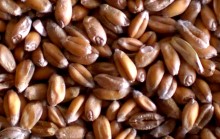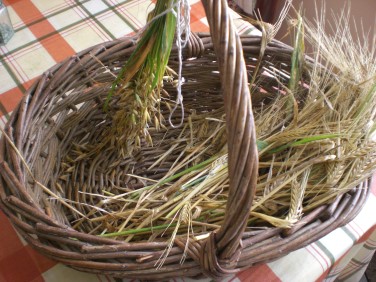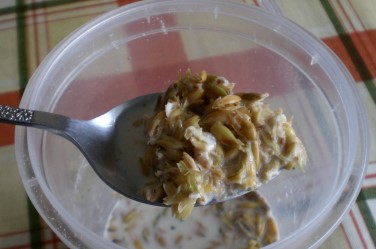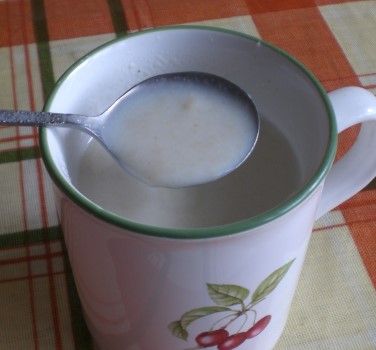Project Wholegrain - Garden-Scale Cereal Crops
By Mike on Saturday, August 13, 2011, 21:22 - Permalink
 Most vegetable crops that are grown commercially are also popular with small scale home gardeners, however, this doesn't seem to be the case for cereal crops. So this year - 2011 - I'm going to give it a try - growing grain on a very small scale
Most vegetable crops that are grown commercially are also popular with small scale home gardeners, however, this doesn't seem to be the case for cereal crops. So this year - 2011 - I'm going to give it a try - growing grain on a very small scale
Objective
It's no use growing the stuff unless I have a purpose in mind, so here's the overall plan:
- Grow enough oats to make a bowl of porridge
- Grow enough wheat to make a loaf of bread
- Grow enough barley to make a gallon of beer
Obviously there's more to it than just growing the stuff - harvesting, threshing, drying and cleaning the grain will be things that I have to work out how to do - and probably using either novel, or very ancient methods - as the techniques used by industrial scale agriculture probably won't fit an operation of this size.
Can It Even Work?
I feel fairly confident that I can raise some kind of crop - because accidental seedlings of oats, wheat, barley and millet (from pet foods) have grown as weeds in my vegetable patch before - and have ripened and produced ears with grain inside.
Candidate Grains
I considered growing millet, rice and corn, but decided that I want to keep this project simple and useful to me - I know what I want to make with the three grain varieties I've chosen.
Possible Pitfalls
These plants are pollinated by the wind - it's possible that such a small crop might not have the critical mass necessary to pollinate itself, but I don't think that will be a problem, as I've had even single ears of grain (that grew as weeds) producing seeds in this garden.
Mechanical damage is a possibility - and I may need to protect my small fields against wind - because the edge-to-area ratio is so much higher than it would be in a large field, my crop could be vulnerable to fraying away to nothing.
Why 'Wholegrain'
This project is about whole grain in more ways that one - the end products will probably be wholegrain in the culinary sense, but this is also about the whole life of the grain - from seed, to plant, to ear, to loaf.
Processing Experiments
When my grain harvest is ripe, I want to be ready to use it - so I've been starting a few experiments with some of the leftover seed stock.
I tried feeding the oat groats through my old-fashioned hand-cranked meat mincer - the results are really promising - a coarse, but soft oatmeal that looks just perfect for making breakfast. I think I just made steel-cut oats.
Wheat doesn't work well in the mincer - it does get broken up, but only into a very coarse and granular meal. I will need to find a way of properly grinding it.
I've also started soaking a large handful of wheat - I'm going to see if I can turn it into malt... updates on progress to follow...
Each of those desired end products requires further processing too - the porridge oats will need to be rolled or cut - the wheat will need milling into flour or meal - the barley will need to be transformed into malt. I'm not daunted though - this is about as far from cutting-edge as it's possible to get - so I'll have a wealth of tradition and history to draw upon and rediscover.
I bought my wheat at the feed store at Botley Mill - there has been a mill on this site for at least a thousand years. I have no idea what kind of wheat it is - so it's probably something not ideally suited to grinding for bread flour, but I'm certain I'll be able to do something with it, assuming I actually manage to raise a crop.
I already had some oats - unprocessed oats are called 'groats', and they're the favourite food of my pet budgie.
Barley proved harder to source, however - it's widely available in 'pearl' form, but I believe that has been processed too much to be able to germinate. Eventually, I found a brewing supplier who could sell me half a kilo of plain barley grain.
I'm going to be attempting to grow the cereals in one end of my small vegetable plot - setting aside an area about two metres by three, for all three crops.
This is, I realise, a very small patch, but my goals are fairly modest.
After preparing the soil by digging it over, then raking the surface, I scattered the seed by hand - using about four generous handfuls of each type of grain.
The oats got the patch nearest the greenhouse, which gets a bit of shade at some times of the day - then the wheat. The barley will go into the sunniest of the three patches.
After gently raking the grain into the surface of the soil, then tamping down, I covered the sown seeds with agricultural fleece.
This will prevent pigeons from stealing the grain - it will also keep cats off the freshly-turned soil and on top of that, it will help to keep the soil warm and moist, by insulating it and preventing wind-driven evaporation.
My barley arrived on 28th March - a week after the oats and wheat were sown. I'll get this straight into the soil.
Despite my precautions, the pigeons turned over one corner of the fleece covering and stole some of my wheat - not enough to matter, but if this persists as a problem, I'll be treating the pigeons as a food source themselves - so they'd better watch out.
I sowed the barley onto watered prepared ground, then raked over a thin layer of soil and tamped it down.
I covered this area with fleece and gave it another water. Now it's just a case of keeping everything watered and watching for signs of emerging shoots.
06 April 2011
I've been away for a week and returned to find that changes have taken place...
The Barley (closest to the camera) has produced stiff, slender little shoots about an inch tall - although I think there are more to come. The wheat (middle) is like a lawn.
The oats (furthest from camera) don't seem to be doing anything - and the kernels that have been unearthed by the rain show no sign of sprouting.
It may be that the seed (bought as feed) I had isn't viable for some reason - perhaps it has been heat treated or something, to preserve it. I'll run a germination test in a container indoors and see what I get.
09 April 2011
I soaked some of the oat groats in water and left them for a few days. Some of them burst right open within a few minutes of getting wet. None of them showed any sign of germination and after three days, the container started to smell sour and yeasty - they're not going to grow.
Searching around a bit, it seems that oat groats are most likely heat or steam treated (once I suspected this, it was easier to find out by Googling, but you don't know what you don't know).
So anyway, I need to try to find a source of raw oat grains. I think it might be possible to buy these as 'cat grass seeds', but need to research it further.
16 April 2011
I bought some organic oat groats in a health food shop and ran another germination test.
Unfortunately, 'organic' doesn't mean raw or unprocessed here - these groats appear to have been heat treated and wouldn't germinate. At this point, it's starting to look unlikely that the project is going to produce a crop of oats.
But wait! I was feeding my daughter's gerbils and noticed that the food mix contains oat grains still in their husks.
I don't have time to test-germinate these, so I'm just going to plant some and hope for the best.
It took me half an hour to pick out a handful of oat grains - not enough to cover a full plot, so I'm probably going to experiment with some minor cereals such as millet.
I planted a narrow strip of oats at the front of the plot. At the back, I sowed a couple of handfuls of budgie mix, which is a blend of millet and other small cereal grains.
In between, I planted a small amount of 'soaking seed', which appears to be a mixture of non-cereal seeds. No idea what this will produce...
The barley and wheat had grown to about four inches tall, so I took off the fleece - the very next morning, the plants were showing signs of being trampled - probably by pigeons searching for unsprouted seeds to eat.
Fortunately, I had the remains of a couple of home made rabbit/guinea pig runs - which by striking coincidence, are just the right size to protect my plots of young cereals. If the pigeons get in here, they may not get out again - and I might put pigeon pie on the menu.
23 April 2011
At last! - the oats have germinated and are about an inch tall. I only hope it isn't too later in the season to be starting - hopefully they'll catch up, as oats can crop in a shorter season than wheat, which is one of the reasons they have been a traditional crop in northern regions.
The millet looks like it's doing something too.
 I've been busy on a whole load of other projects, so haven't given this page the attention it deserves - so, to bring things up to date; The wheat, oats and barley have all grown well and produced some ears, some of which are ripening.
I've been busy on a whole load of other projects, so haven't given this page the attention it deserves - so, to bring things up to date; The wheat, oats and barley have all grown well and produced some ears, some of which are ripening.
There have been problems however - I think I planted too densely, which resulted in a turf of seedlings coming up, whiich then struggled to mature. I've also been pestered by cats flattening down the stalks and pigeons following along and eating the ripe grain.
 On top of all that, ripening itself has been uneven - so I've had to harvest the stalks individually by hand. If I leave them ripe in situ, the birds will get them.
On top of all that, ripening itself has been uneven - so I've had to harvest the stalks individually by hand. If I leave them ripe in situ, the birds will get them.
At the moment, I've got a couple of little bunches each of barley and oats harvested. There's more to come, but it's not going to be a massive crop.
Clearly, the crop is going to fall short of my hopes here, so I've supplemented my meagre harvest by going out gleaning.
Oat Harvest
 I harvested about half of my oats - which was a thick fistful of stalks.
I harvested about half of my oats - which was a thick fistful of stalks.
The oats were easy to thresh (at least in part) - the stalks are soft and just pulling them through the fingers strips the grain off. Rubbing these between the palms removed the outer husks.
However, there's an additional inner husk layer that doesn't seem to rub off. The naked grain can be picked out with the fingernails, but clearly, that's going to be too much effort to do in bulk.
I think this is probably a feed variety of oats, rather than a culinary one - certainly when I've gleaned oats in the past, they were not so tricky to de-husk.
 I crushed the oats in their husks with my granite mortar and pestle, hoping that the lighter husks could then be blown away, but unfortunately this was not to be, as the crushed kernels were quite light and flaky too.
I crushed the oats in their husks with my granite mortar and pestle, hoping that the lighter husks could then be blown away, but unfortunately this was not to be, as the crushed kernels were quite light and flaky too.
So I went for a compromise. I soaked the crushed oats (with husks) in milk overnight, then pressed the mixture through a sieve. Wasteful, but the best I could think of.
 I topped the resulting mixture up with milk and cooked it in the microwave.
I topped the resulting mixture up with milk and cooked it in the microwave.
So I ended up with a full mug of thickish, porridge-flavoured drink - Sweetened with just a little sugar, this was really tasty and satisfying. Although obviously, I'd have preferred actual porridge.
I still have the other half of the crop to harvest - so maybe I'll work out a way to fully thresh them...
Conclusions

It's the 8th of October and I'm declaring this experiment at an end. Results have been disappointing.
Yields have been low - the only crop that produced more grain than I used in sowing was the oats. The barley has produced a handful of grain that looks smaller and more weedy than the seed from which it grew. The wheat produced a few ears, but they contain no worthwhile grains at all.
What Went Wrong
Failure is probably attributable to a number of factors here - the plot on which I grew the grain probably isn't ideal, as it gets too much shade, and is a bit of a wind tunnel.
Also, I think this is just too small a scale to work. If you look at the edges of a farmed field of grain, they're often weedy, stunted and weatherbeaten - my little plots were all edge, in this context.
And I just don't know what I'm doing. I probably didn't sow at the optimal time, or with the right seed density (actually, I know I planted too thickly).
What Next?
I don't have enough of a crop to do anything much with it. I might add the barley to a beer making project later on.
